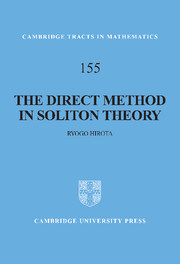Afterword
Published online by Cambridge University Press: 13 August 2009
Summary
No sooner had the author started to describe an application of the direct method that he realized that he had used up the allotted space on the fundamentals. Even though he thought of shortening some of the detailed explanations, he remembered that he had suffered reading difficult mathematics books because of their terse style, and so decided to retain the seemingly superfluous remarks.
Let us briefly mention some topics not discussed in the book.
Fundamental soliton equations such as the KP, BKP and Toda equations and their Bäcklund transformation formulae may be regarded as ‘atoms’ for constructing various kinds of soliton equations. Combination of these equations generate many other soliton equations and their solutions. Modern science has been able to understand the properties of materials by decomposing them into their constituents, or atoms, and has managed to create new materials by combining different atoms. It is a pity that lack of space prevented the author explaining how to construct new soliton equations from the above atoms. For example, the KP equation and its Bäcklund transformation formula may also be considered as the bilinear form of the nonlinear Schrödinger equation. In this way, we can construct the dromion solution (two-dimensionally localized soliton) for the Davey—Stewartson equation. It should also be noted that apparently different nonlinear partial differential equations are frequently transformed into the same bilinear form.
[…]
- Type
- Chapter
- Information
- The Direct Method in Soliton Theory , pp. 192 - 194Publisher: Cambridge University PressPrint publication year: 2004



